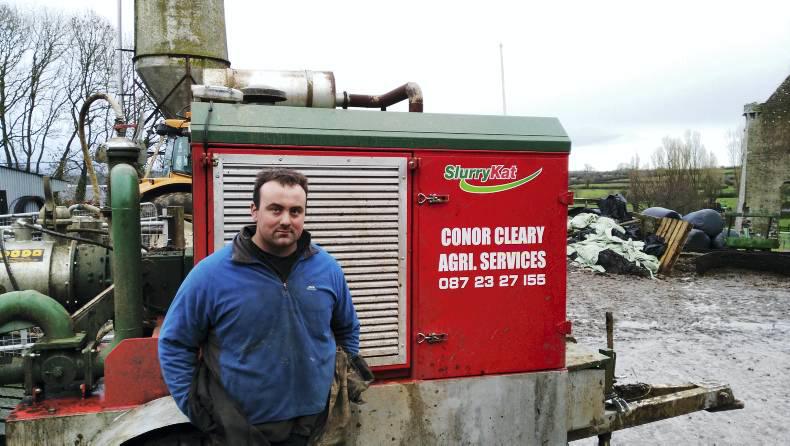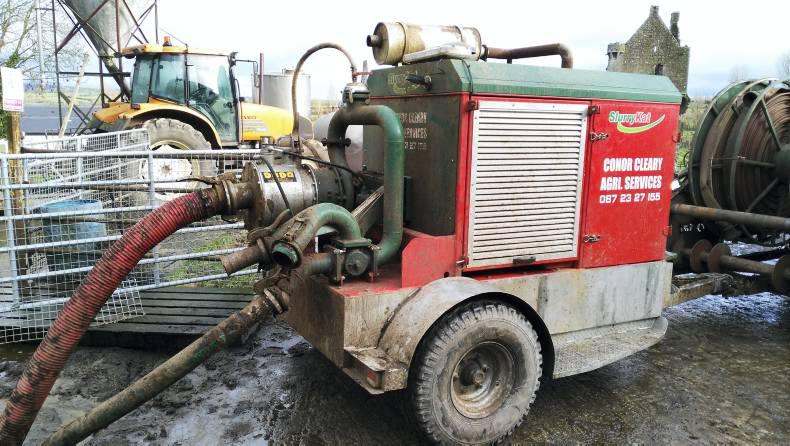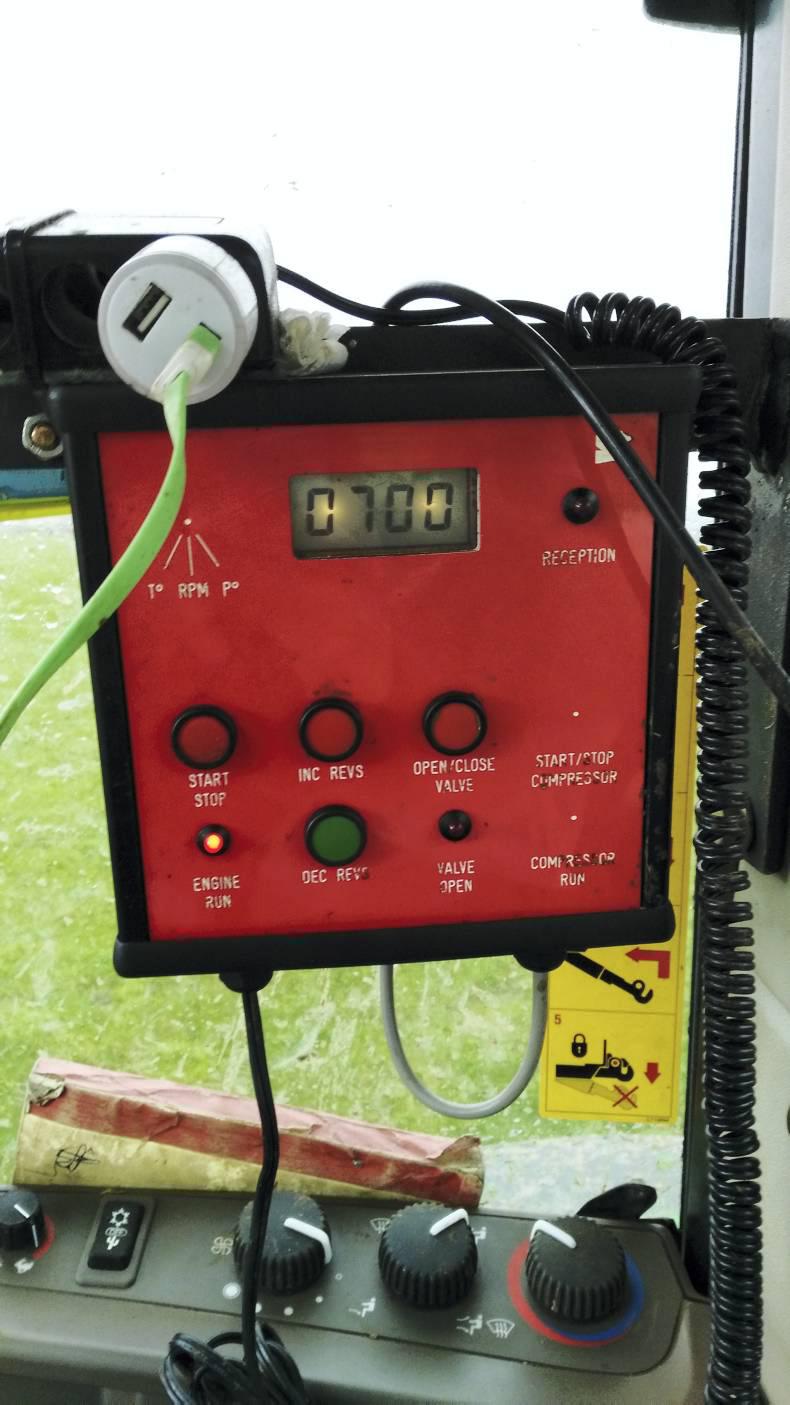Conor Cleary from Hospital in Co Limerick caught the machinery bug at an early age working at his uncle’s agri-contracting business.
After finishing school in 2008, Conor made the decision to give in to the temptation and set up Conor Cleary Agri Services. Starting off with two tractors, a 1995 John Deere 6800 and a 1990 Ford TW 15, a Major 6000 slurry agitator, a Belmac 2000 vacuum tanker and a McConnell 2050 hedgecutter, Conor established a good customer base within a 20-mile radius of his base in Hospital.
Between 2008 and 2016, Conor has made many changes to his machinery fleet to help expand his business. In 2009, the Ford TW 15 was changed and replaced by a 1995 John Deere 7700. In 2010, the John Deere 6800 was changed for a 2008 John Deere 6930 and the McConnell 2050 was changed for a newer 650 version. Then, in 2011, the Belmac vacuum tanker was replaced by an Abbey 2500 version.
2012 marked what was to be a turning point in the business when Conor made a significant investment in a slurry umbilical system. “2012 was an extremely wet year and we simply couldn’t travel the ground with the vacuum tanker, so it was either change our system or get out,” Conor said.
SlurryKat from Co Armagh was the next stop for Conor where he purchased a 7.5m dribble bar system. The new system includes a front reeler complete with 600m of piping and a rear reeler unit complete with 1,200m of piping.
The system also includes a DODA HD 35 slurry pump. This was a huge investment of €58,500 plus VAT. If that wasn’t enough, the McConnell hedgecutter was also changed to a 6500 model, along with the Major agitator being replaced by a NC 3800. Commenting on the investment, Conor informs us that “customers were looking for the service and, as slurry was my main enterprise, I had to give them what they wanted or risk losing their business”.
Since offering the umbilical slurry service, Conor has extended his working radius from 30 to 100km from his yard and established an ever-growing customer base. “We are now busy 10 months of the year with the umbilical system as we can travel in any conditions,” Conor said.
2015 saw another major investment with the John Deere 6930 traded in for a new 6170M fitted with front linkage and shod on Michelin 650 rear and 600 front tyres to help with ground compaction. This came at a total cost of €93,500 plus VAT. The John Deere 7700 was also changed that year for a 2000 New Holland TM165.
In December 2015, Conor looked at his umbilical operation and made the decision to make it more efficient. This was achieved by the purchase of a new automatic engine-driven pumping station supplied by SlurryKat at a cost of €54,000 plus VAT.
The engine-driven pumping station is essentially a Doda L35 pump mated to a six-cylinder Iveco turbo-charged engine producing 200hp – the horsepower requirement for the pump is a minimum of 150hp.
This unit is fitted to a galvanised chassis and can be towed behind the tractor and dribble bar during transport. The entire machine is remotely controlled in the tractor cab via an electronic control box, up to a claimed distance of 80km. The control box can increase and decrease the engine revs on the pump and open and close the valve to let the slurry out the pipes to the dribble bar.
There is also an option to fit controls to operate an air compressor unit to blow out the pipes after use, which Conor will be fitting in the coming months.
The pumping station is constantly monitored for engine temperature, fuel level, oil pressure and pump flow. If there are any problems, the engine will go into safe mode and switch off while a code will appear in the tractor cab to warn the operator.
The pump itself is self-priming. When primed, the main valve is opened remotely in the tractor cab, allowing slurry to travel out to the applicator. In the event of an emergency, the main valve can be closed. The slurry will then circulate back to the tank which eliminates the process of priming again, allowing the operator to return to work almost immediately.
The slurry passes through a macerator on the pumping station before being pumped out of the umbilical system pipes where it passes through another macerator on the dribble bar, eliminating the possibility of blockages.
The major advantage of this system is the elimination of one tractor which would normally power the pump. Although still engine-driven, Conor has already seen a fuel consumption decrease of 30% compared with the previous setup.
Another major saving with the new system is that it’s now a one-man operation, which eliminates the need for an extra man and wage. “Help is hard to find and at least now when I get the call I can just go. There is no more waiting for lads to arrive or being let down at the last minute,” Conor said. The John Deere 6170M operates at just 1,000rpm and Conor can get three days out of the 420-litre fuel tank, but with 650 hours on the clock he is confident that this will further improve.
The pumping station can pump well-agitated slurry up to a distance of 1,800m and has an output of up to 25,000 gallons/hr. “We can get out up to 300,000 gallons of slurry in a good day,” says Conor, depending on the field layout and size.
Charging €120/hour inclusive of VAT, the umbilical system is significantly more expensive than a vacuum tanker which costs €50/hour inclusive of VAT. The umbilical system has an output which is claimed to be three times greater than that of a vacuum tanker for the same duration.
Once the system and pipes are set up, there is no need to stop or travel to and from the farmyard, which eliminates soil compaction, damage to roadways and gaps, and also the added danger of bringing muck out on to public roads.
Conor’s plans for the future are to continue to build on his established customer base through hard work and a good reputation. He hopes to keep his machinery fleet updated and well maintained to provide a top-quality reliable service.
The main advantage of an umbilical system is that slurry can be spread on all ground conditions, with soil compaction reduced drastically by the decreased weight and aided further by the use of LGP tyres.
However, there are also disadvantages to the system. The slurry must be agitated correctly and free of foreign bodies. There is time needed to set up and pack up pipes when finished, although once working there should be no need for stoppages. Umbilical slurry spreading is more expensive for the farmer, coupled with the cost of investment for the contractor.






 This is a subscriber-only article
This is a subscriber-only article









SHARING OPTIONS: